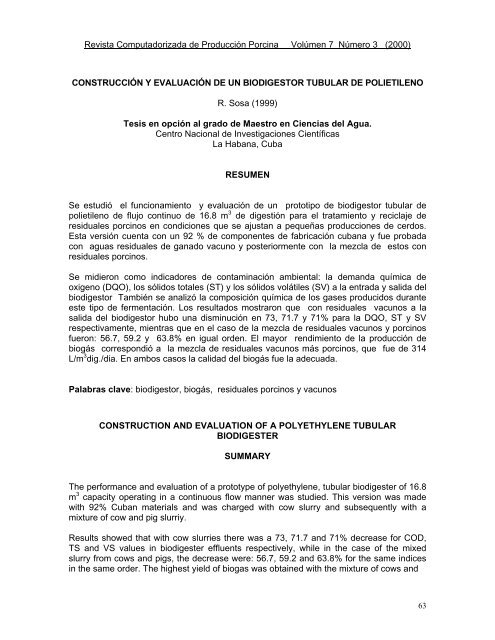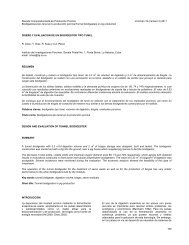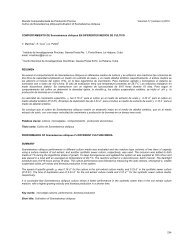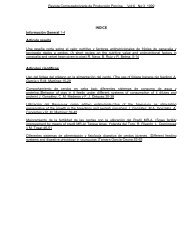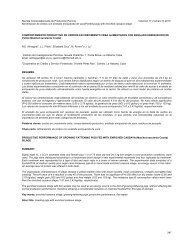Descargar Revista - Instituto de Investigaciones Porcinas (IIP)
Descargar Revista - Instituto de Investigaciones Porcinas (IIP)
Descargar Revista - Instituto de Investigaciones Porcinas (IIP)
Create successful ePaper yourself
Turn your PDF publications into a flip-book with our unique Google optimized e-Paper software.
<strong>Revista</strong> Computadorizada <strong>de</strong> Producción Porcina Volúmen 7 Número 3 (2000)<br />
CONSTRUCCIÓN Y EVALUACIÓN DE UN BIODIGESTOR TUBULAR DE POLIETILENO<br />
R. Sosa (1999)<br />
Tesis en opción al grado <strong>de</strong> Maestro en Ciencias <strong>de</strong>l Agua.<br />
Centro Nacional <strong>de</strong> <strong>Investigaciones</strong> Científicas<br />
La Habana, Cuba<br />
RESUMEN<br />
Se estudió el funcionamiento y evaluación <strong>de</strong> un prototipo <strong>de</strong> biodigestor tubular <strong>de</strong><br />
polietileno <strong>de</strong> flujo continuo <strong>de</strong> 16.8 m 3 <strong>de</strong> digestión para el tratamiento y reciclaje <strong>de</strong><br />
residuales porcinos en condiciones que se ajustan a pequeñas producciones <strong>de</strong> cerdos.<br />
Esta versión cuenta con un 92 % <strong>de</strong> componentes <strong>de</strong> fabricación cubana y fue probada<br />
con aguas residuales <strong>de</strong> ganado vacuno y posteriormente con la mezcla <strong>de</strong> estos con<br />
residuales porcinos.<br />
Se midieron como indicadores <strong>de</strong> contaminación ambiental: la <strong>de</strong>manda química <strong>de</strong><br />
oxigeno (DQO), los sólidos totales (ST) y los sólidos volátiles (SV) a la entrada y salida <strong>de</strong>l<br />
biodigestor También se analizó la composición química <strong>de</strong> los gases producidos durante<br />
este tipo <strong>de</strong> fermentación. Los resultados mostraron que con residuales vacunos a la<br />
salida <strong>de</strong>l biodigestor hubo una disminución en 73, 71.7 y 71% para la DQO, ST y SV<br />
respectivamente, mientras que en el caso <strong>de</strong> la mezcla <strong>de</strong> residuales vacunos y porcinos<br />
fueron: 56.7, 59.2 y 63.8% en igual or<strong>de</strong>n. El mayor rendimiento <strong>de</strong> la producción <strong>de</strong><br />
biogás correspondió a la mezcla <strong>de</strong> residuales vacunos más porcinos, que fue <strong>de</strong> 314<br />
L/m 3 dig./dia. En ambos casos la calidad <strong>de</strong>l biogás fue la a<strong>de</strong>cuada.<br />
Palabras clave: biodigestor, biogás, residuales porcinos y vacunos<br />
CONSTRUCTION AND EVALUATION OF A POLYETHYLENE TUBULAR<br />
BIODIGESTER<br />
SUMMARY<br />
The performance and evaluation of a prototype of polyethylene, tubular biodigester of 16.8<br />
m 3 capacity operating in a continuous flow manner was studied. This version was ma<strong>de</strong><br />
with 92% Cuban materials and was charged with cow slurry and subsequently with a<br />
mixture of cow and pig slurriy.<br />
Results showed that with cow slurries there was a 73, 71.7 and 71% <strong>de</strong>crease for COD,<br />
TS and VS values in biodigester effluents respectively, while in the case of the mixed<br />
slurry from cows and pigs, the <strong>de</strong>crease were: 56.7, 59.2 and 63.8% for the same indices<br />
in the same or<strong>de</strong>r. The highest yield of biogas was obtained with the mixture of cows and<br />
63


